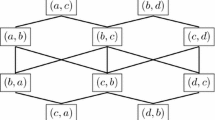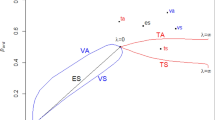Abstract
There exists a large literature on two-person bargaining games and distribution games (or divide-the-dollar games) under simple majority rule, where in equilibrium a minimal winning coalition takes full advantage over everyone else. Here we extend the study to an n-person veto game where players take turns proposing policies in an n-dimensional policy space and everybody has a veto over changes in the status quo. Briefly, we find a Nash equilibrium where the initial proposer offers a policy in the intersection of the Pareto optimal set and the Pareto superior set that gives everyone their continuation values, and punishments are never implemented. Comparing the equilibrium outcomes under two different agendas – sequential recognition and random recognition – we find that there are advantages generated by the order of proposal under the sequential recognition rule. We also provide some conditions under which the players will prefer to rotate proposals rather than allow any specific policy to prevail indefinitely.
Similar content being viewed by others
References
Banks, J.S. and Gasmi, F. (1987). Endogenous agenda formation in three-person committees. Social Choice and Welfare4: 133-152.
Baron, D.P. and Ferejohn, J.A. (1989). Bargaining in legislatures. American Political Science Review83: 1181-1206.
Binmore, K.G. and Herrero, M.J. (1988). Security equilibrium. Review of Economic Studies55: 33-48.
Buchanan, J.M. and Tullock, G. (1962). The calculus of consent. Ann Arbor: University of Michigan Press.
Calhoun, J.C. (1853). A disquisition on government. Indianapolis: Bobbs-Merrill.
Hammond, T.H. and Miller, G.J. (1987). The core of the Constitution. American Political Science Review81: 1155-1174.
Laing, J.D. and Slotznick, B. (1991). When anyone can veto: A laboratory study of committees governed by unanimous rule. Behavioral Science36: 179-195.
Matthews, S.A. (1989). Veto threats: Rhetorics in a bargaining game. The Quarterly Journal of Economics104: 348-369.
McKelvey, R.D. and Riezman, R. (1990). Seniority in legislature. Social Science Working Paper 725. Caltech.
Miller, G.J. and Hammond, T.H. (1990). Committees and the core of the constitution. Public Choice66: 201-227.
Ordeshook, P.C. and Schwartz, T. (1987). Agendas and the control of political outcomes. American Political Science Review81: 179-199.
Riker, W.H. (1982). Liberalism against populism. San Francisco: W.H. Freeman.
Rubinstein, A. (1982). Perfect equilibrium in a bargaining model. Econometrica50: 97-109.
Sobel, M.J. (1971). Noncooperative stochastic games. The Annals of Mathematical Statistics42: 1930-1935.
Author information
Authors and Affiliations
Rights and permissions
About this article
Cite this article
Chen, Y., Ordeshook, P.C. Veto games: Spatial committees under unanimity rule. Public Choice 97, 617–643 (1998). https://doi.org/10.1023/A:1004951809854
Issue Date:
DOI: https://doi.org/10.1023/A:1004951809854




